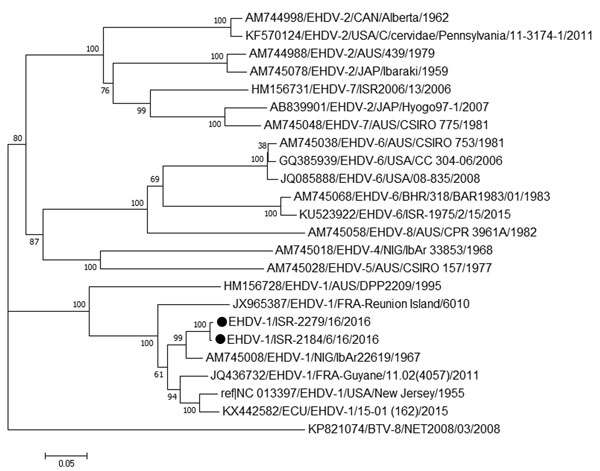Volume 25, Number 4—April 2019
Research Letter
Detection of Epizootic Hemorrhagic Disease Virus Serotype 1, Israel
Figure

Figure. Phylogenetic analysis based on full-length sequences of segment 2 in 2 EHDV serotype 1 isolates from Israel with global EHDVs and BTV-8 from GenBank. We analyzed 24 nucleotide sequences and inferred phylogenetic relationship by using the neighbor-joining method. Numbers below branches indicate bootstrap values. Recent isolates from Israel are marked with black circles. Viruses are identified by GenBank accession number, virus and serotype, 3-letter code of country (and additional information in some cases), isolate identification (in most cases), and year of isolates. Evolutionary analyses were conducted in MEGA7 (8). Scale bar indicates number of nucleotide substitutions per site. BTV, bluetongue virus; EHDV, epizootic hemorrhagic disease virus.
References
- Savini G, Afonso A, Mellor P, Aradaib I, Yadin H, Sanaa M, et al. Epizootic heamorragic disease. Res Vet Sci. 2011;91:1–17. DOIPubMedGoogle Scholar
- Weir RP, Harmsen MB, Hunt NT, Blacksell SD, Lunt RA, Pritchard LI, et al. EHDV-1, a new Australian serotype of epizootic haemorrhagic disease virus isolated from sentinel cattle in the Northern Territory. Vet Microbiol. 1997;58:135–43. DOIPubMedGoogle Scholar
- Cêtre-Sossah C, Roger M, Sailleau C, Rieau L, Zientara S, Bréard E, et al. Epizootic haemorrhagic disease virus in Reunion Island: evidence for the circulation of a new serotype and associated risk factors. Vet Microbiol. 2014;170:383–90. DOIPubMedGoogle Scholar
- Subramaniam K, Lednicky JA, Loeb J, Sayler KA, Wisely SM, Waltzek TB. Genomic sequences of epizootic hemorrhagic disease viruses isolated from Florida white-tailed deer. Genome Announc. 2017;5:e01174–17. DOIPubMedGoogle Scholar
- Yadin H, Brenner J, Bumbrov V, Oved Z, Stram Y, Klement E, et al. Epizootic haemorrhagic disease virus type 7 infection in cattle in Israel. Vet Rec. 2008;162:53–6. DOIPubMedGoogle Scholar
- Golender N, Khinich Y, Gorohov A, Abramovitz I, Bumbarov V. Epizootic hemorrhagic disease virus serotype 6 outbreak in Israeli cattle in 2015. J Vet Diagn Invest. 2017;29:885–8. DOIPubMedGoogle Scholar
- Golender N, Bumbarov VY, Erster O, Beer M, Khinich Y, Wernike K. Development and validation of a universal S-segment-based real-time RT-PCR assay for the detection of Simbu serogroup viruses. J Virol Methods. 2018;261:80–5. DOIPubMedGoogle Scholar
- Kumar S, Stecher G, Tamura K. MEGA7: Molecular Evolutionary Genetics Analysis version 7.0 for bigger datasets. Mol Biol Evol. 2016;33:1870–4. DOIPubMedGoogle Scholar
- Golender N, Eldar A, Khinich Y, Kenigswald G, Bumbarov V. Novel topotypes of bluetongue serotype 3 viruses in the Mediterranean Basin. In: Abstracts of the 11th EPIZONE Annual Meeting, Paris, France, 2017 Sep 19–21. Abstract C1; p. 26.
- Golender N, Brenner J, Valdman M, Khinich Y, Bumbarov V, Panshin A, et al. Malformations caused by Shuni virus in ruminants, Israel, 2014–2015. Emerg Infect Dis. 2015;21:2267–8. DOIPubMedGoogle Scholar
1Both authors share first authorship.